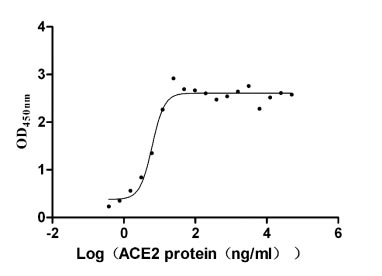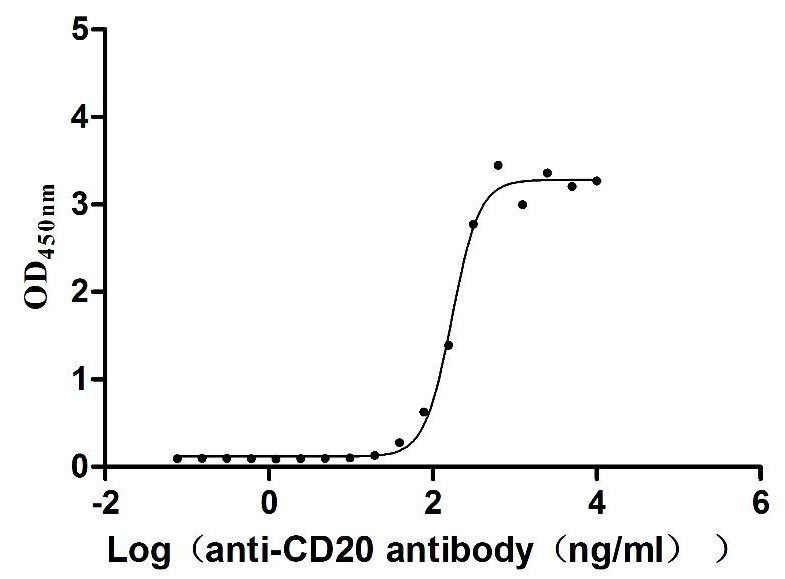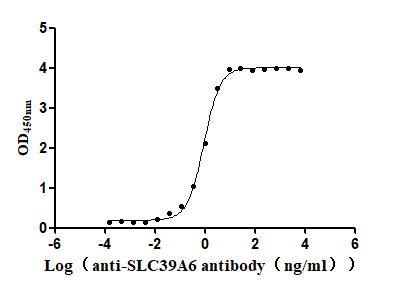Recombinant Mouse Brachyury protein (T)
-
中文名称:小鼠T重组蛋白
-
货号:CSB-YP023052MO
-
规格:
-
来源:Yeast
-
其他:
-
中文名称:小鼠T重组蛋白
-
货号:CSB-EP023052MO
-
规格:
-
来源:E.coli
-
其他:
-
中文名称:小鼠T重组蛋白
-
货号:CSB-EP023052MO-B
-
规格:
-
来源:E.coli
-
共轭:Avi-tag Biotinylated
E. coli biotin ligase (BirA) is highly specific in covalently attaching biotin to the 15 amino acid AviTag peptide. This recombinant protein was biotinylated in vivo by AviTag-BirA technology, which method is BriA catalyzes amide linkage between the biotin and the specific lysine of the AviTag.
-
其他:
-
中文名称:小鼠T重组蛋白
-
货号:CSB-BP023052MO
-
规格:
-
来源:Baculovirus
-
其他:
-
中文名称:小鼠T重组蛋白
-
货号:CSB-MP023052MO
-
规格:
-
来源:Mammalian cell
-
其他:
产品详情
-
纯度:>85% (SDS-PAGE)
-
基因名:T
-
Uniprot No.:
-
别名:Tbxt; T; T-box transcription factor T; Brachyury protein; Protein T
-
种属:Mus musculus (Mouse)
-
蛋白长度:Full length protein
-
表达区域:1-436
-
氨基酸序列MSSPGTESAG KSLQYRVDHL LSAVESELQA GSEKGDPTER ELRVGLEESE LWLRFKELTN EMIVTKNGRR MFPVLKVNVS GLDPNAMYSF LLDFVTADNH RWKYVNGEWV PGGKPEPQAP SCVYIHPDSP NFGAHWMKAP VSFSKVKLTN KLNGGGQIML NSLHKYEPRI HIVRVGGPQR MITSHCFPET QFIAVTAYQN EEITALKIKY NPFAKAFLDA KERNDHKDVM EEPGDCQQPG YSQWGWLVPG AGTLCPPASS HPQFGGSLSL PSTHGCERYP ALRNHRSSPY PSPYAHRNSS PTYADNSSAC LSMLQSHDNW SSLGVPGHTS MLPVSHNASP PTGSSQYPSL WSVSNGTITP GSQTAGVSNG LGAQFFRGSP AHYTPLTHTV SAATSSSSGS PMYEGAATVT DISDSQYDTA QSLLIASWTP VSPPSM
-
蛋白标签:Tag type will be determined during the manufacturing process.
The tag type will be determined during production process. If you have specified tag type, please tell us and we will develop the specified tag preferentially. -
产品提供形式:Lyophilized powder
Note: We will preferentially ship the format that we have in stock, however, if you have any special requirement for the format, please remark your requirement when placing the order, we will prepare according to your demand. -
复溶:We recommend that this vial be briefly centrifuged prior to opening to bring the contents to the bottom. Please reconstitute protein in deionized sterile water to a concentration of 0.1-1.0 mg/mL.We recommend to add 5-50% of glycerol (final concentration) and aliquot for long-term storage at -20℃/-80℃. Our default final concentration of glycerol is 50%. Customers could use it as reference.
-
储存条件:Store at -20°C/-80°C upon receipt, aliquoting is necessary for mutiple use. Avoid repeated freeze-thaw cycles.
-
保质期:The shelf life is related to many factors, storage state, buffer ingredients, storage temperature and the stability of the protein itself.
Generally, the shelf life of liquid form is 6 months at -20°C/-80°C. The shelf life of lyophilized form is 12 months at -20°C/-80°C. -
货期:Delivery time may differ from different purchasing way or location, please kindly consult your local distributors for specific delivery time.Note: All of our proteins are default shipped with normal blue ice packs, if you request to ship with dry ice, please communicate with us in advance and extra fees will be charged.
-
注意事项:Repeated freezing and thawing is not recommended. Store working aliquots at 4°C for up to one week.
-
Datasheet :Please contact us to get it.
靶点详情
-
功能:Involved in the transcriptional regulation of genes required for mesoderm formation and differentiation. Binds to a palindromic T site 5'-TTCACACCTAGGTGTGAA-3' DNA sequence and activates gene transcription when bound to such a site.
-
基因功能参考文献:
- we developed in vitro fertilization (IVF) methods for the BTBR mouse. We found low rates of fertilization and implantation in this strain, and identified the BTBR oocyte as the primary culprit of low success with BTBR IVF. PMID: 27515175
- including Wnt and Fgf pathway components active in the axial progenitor niche. Our data demonstrate that integration of the Cdx2 and T Brachyury transcriptional networks controls differential axial growth during vertebrate trunk elongation PMID: 28009287
- T is required for correct axial positioning of the vessel of confluence. PMID: 28389228
- Wnt3a, which regulate cell growth, were also expressed strongly during E12.5-E13.5. On the other hand, cleft formation and branching morphogenesis was suppressed by knockdown of Brachyury gene, suggesting that Brachyury plays a central role in regulating cell growth and cleft formation in early-stage embryonic mouse salivary gland development PMID: 27369076
- Epiblast stem cells are discriminated by the expression of a specific marker T (Brachyury) into two populations. PMID: 27226536
- T function is essential for maintaining notochord cell fate and function. Progenitors adopt predominantly a neural fate in the absence of T, consistent with an origin from a common chordoneural progenitor. PMID: 27006501
- data confirmed that Brachyury might contribute to hypoxia-induced EMT of breast cancer and trigger HIF-1alpha expression via PTEN/Akt signaling PMID: 26393908
- Results showed that the expression levels of HDAC1 and 3 are decreased gradually during embryonic stem cells (ESCs) mesodermal differentiation and interact physically with Bry protein, which is critical for mesodermal lineage commitment. PMID: 25412078
- Epithelial-to-mesenchymal transition (EMT) initiates the controlled differentiation of embryonic stem cells, which is both fuelled and terminated by the action of brachyury, whose expression is dependent on the EMT and beta-catenin activity. PMID: 25115237
- results thus chart a comprehensive map of the Brachyury-mediated gene-regulatory network and how it influences in vivo developmental homeostasis and coordination PMID: 24616493
- T (BRACHYURY), a classical and conserved mesodermal factor, was essential for robust activation of Blimp1 and Prdm14, two of the germline determinants. PMID: 24331926
- In vivo knockdown of Brachyury results in skeletal defects and urorectal malformations resembling caudal regression syndrome PMID: 22995555
- UTX controls mesoderm differentiation and Brachyury expression independent of H3K27 demethylase activity; UTX and UTY are functionally redundant in ES cell differentiation and early embryonic development PMID: 22949634
- We found Tcf3 as a potential target of gene repression by Nkx1-2, and the down-regulation of Tcf3 was partly required for effective activation of Brachyury by Wnt/beta-catenin signaling PMID: 22475651
- Data show that expression of Brachyury targets Axin2, Fgf8 and Wnt3a, is down regulated in Brachyury mutant embryos. PMID: 22479388
- Id1 regulates self-renewal of embryonic stem cells by regulating levels of Nanog and Brachyury. PMID: 22013995
- functions as part of GDNF/ETV5 signaling to promote self-renewal of spermatogonial stem cells cultured in vitro PMID: 21816850
- BRA was necessary for and preceded CDX2 expression. PMID: 21816365
- shRNA-based loss of Brachyury(T) causes a dramatic decrease in MesP1 expression accompanied by reduced cardiac markers in differentiating embryonic stem cells PMID: 21632880
- found that brachyury is not expressed in developing p63-/- mouse embryos, and that in osteosarcomas, DeltaNp63 and brachyury are expressed at high levels PMID: 20519941
- The expression pattern of T and FOXA2 is largely conserved between pig and mouse. PMID: 21394824
- Mouse Brachyury interacts with Brachyenteron via a consensus motif. Mouse Brachyury homologs activate orthopedia expression when expressed in Drosophila embryonic cells. PMID: 11850413
- Brachyury mediates cartilage development in a mesenchymal stem cell line PMID: 11865033
- neither Brachyury nor Wnt3 forms a ring of expression in the proximal epiblast as previously thought PMID: 16289026
- Several novel T' s embryonic expression sites, including the developing heart, visceral endoderm, extraembryonic ectoderm, and its derivative, chorionic ectoderm. PMID: 16545989
- Required to maintain the allantoic core, which is essential for allantoic elongation and vascular patterning. PMID: 16835439
- tint interacts with brachyury 2 but not with brachyury T1; T2 may be part of the T1 regulatory region through direct or indirect participation of tint PMID: 17954925
- the expression of the mesodermal genes Brachyury (Bra) is under regulatory control in P19 cells PMID: 18729134
- Mesenchymal progenitor cells transformed with Brachyury are able to produce a cartilage like tissue in vivo over an extended period of time that is resistant to the destructive effect of rheumatoid arthritis synovial fibroblasts PMID: 19156687
显示更多
收起更多
-
相关疾病:Embryo lacking the T gene fail to form the notochord, the entire posterior region and the allantois, and die at about 10 days of gestation.
-
亚细胞定位:Nucleus.
-
数据库链接:
KEGG: mmu:20997
STRING: 10090.ENSMUSP00000074236
UniGene: Mm.913
Most popular with customers
-
Recombinant Paguma larvata Angiotensin-converting enzyme 2 (ACE2), partial (Active)
Express system: Mammalian cell
Species: Paguma larvata (Masked palm civet)
-
Recombinant Human C-X-C chemokine receptor type 4 (CXCR4)-VLPs (Active)
Express system: Mammalian cell
Species: Homo sapiens (Human)
-
Recombinant Dog B-lymphocyte antigen CD20 (MS4A1)-VLPs (Active)
Express system: Mammalian cell
Species: Canis lupus familiaris (Dog) (Canis familiaris)
-
Recombinant Human IL12B&IL12A Heterodimer Protein (Active)
Express system: Mammalian cell
Species: Homo sapiens (Human)
-
Recombinant Mouse Cytotoxic and regulatory T-cell molecule (Crtam), partial (Active)
Express system: Mammalian cell
Species: Mus musculus (Mouse)
-
Recombinant Human Transmembrane 4 L6 family member 1(TM4SF1)-VLPs (Active)
Express system: Mammalian cell
Species: Homo sapiens (Human)
-
Recombinant Macaca fascicularis Zinc transporter ZIP6 isoform X1(SLC39A6),partial (Active)
Express system: Baculovirus
Species: Macaca fascicularis (Crab-eating macaque) (Cynomolgus monkey)
-
Recombinant Macaca fascicularis Interleukin 1 receptor accessory protein(IL1RAP), partial (Active)
Express system: Mammalian cell
Species: Macaca fascicularis (Crab-eating macaque) (Cynomolgus monkey)



-AC1.jpg)
















